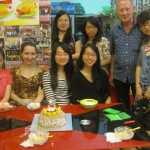Even though I’m beginning this next entry with Lunch, I should mention that here in Argentina, or at least in Buenos Aires, there are really four meals in a day — breakfast, a mid-day meal, lunch in the mid-afternoon, and dinner at no earlier than 8pm. But, I don’t really participate in mid-day meal since I’m already grazing throughout the day. First, lunch in the city is rarely done at home since people are usually out all day working and running errands. For this reason, you can get something quick for lunch practically everywhere. Women sell baskets of milenesa – lettuce and tomato sandwiches with thinly-sliced breaded and fried beef – warm flat bread on grills set-up on the street, and you can get empanadas — sort of like a tiny pie/sandwich small filled with meat, cheese and/or veggies — in just about every pandería or bakery. And for dessert, they usually also sell facturas or pasteries for about 2 pesos which is about 50 cents. Unlike most of us on campus, porteños do not typically eat lunch while walking to their next destination or while sitting on a public bench. While there are of course lots of options for eating outside at restaurants, most porteños feel it is dirty to eat in the streets because there isn’t anywhere to wash your hands. And, unless their bringing something from home, most city-dwellers will go out during their hour-long lunch break to a restaurant close by. They do sell more traditionally-American frozen lunches at the supermarkets here, but they are actually much more expensive than grabbing a couple empanadas or a freshly-made sandwich from down the street.
In general, I’ve been avoiding American-style food while I have this giant opportunity to eat so many things I didn’t even know existed. But, American food is a popular specialty here. In addition to the McDonalds (here pronounced MacDonald’s’), Burger King, and Subway, they just opened up a Wendy’s about 15 blocks from where I’m staying. And, the other day we went in there to get some comfort food: French fries and a frosty to dip them in. Food like that is more expensive here than it is in the US, even with the exchange rate. A typical “meal” from McDonalds is about 2 dollars more that what you’d pay in the US. I will say that the fast food places here are more of an upper-class outing than you’d find in the US. You find them in mostly wealthier neighborhoods, they have much nicer seating areas, there are separate café and icecream kiosks inside, and one in my neighborhood even has an arcade/gym area. And, while I can’t remember the last time I bought fast food in the US, sometimes comfort food is necessary after a long day of classes in Spanish.



